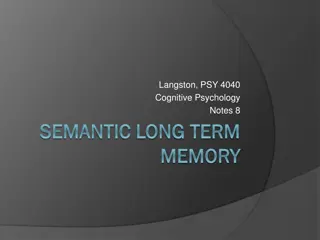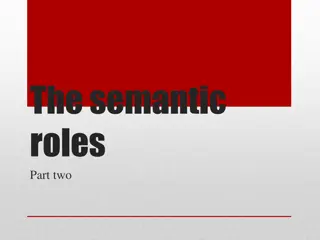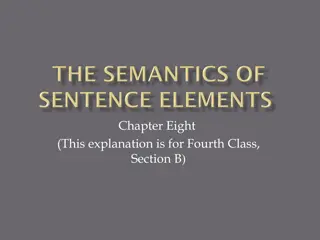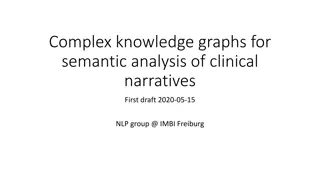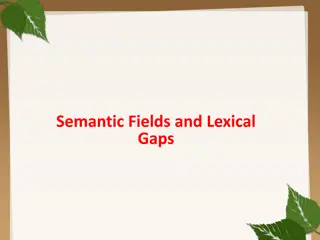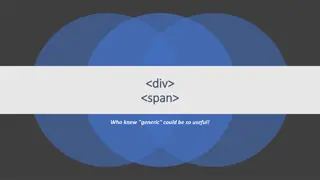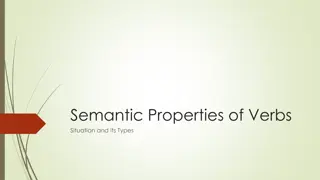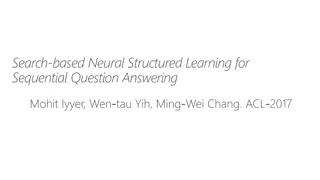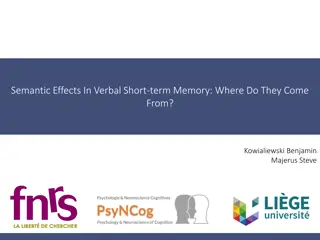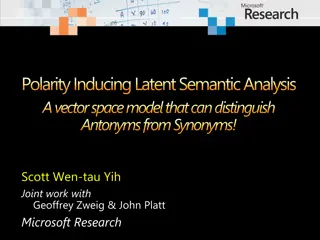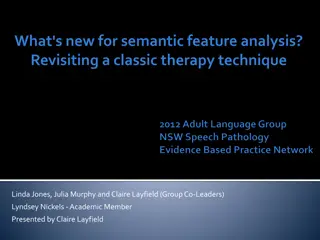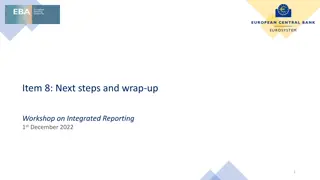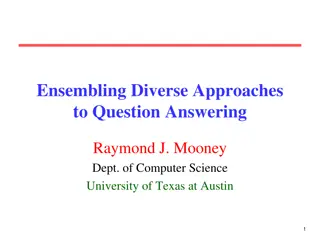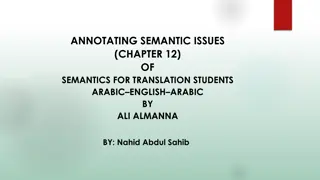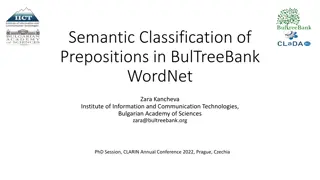
Semantic Tool for Personal Information Protection: Ontology Implementation
"Explore the use of semantic tool and ontology to safeguard personal information in compliance with data protection regulations. Discover successful ontology implementations and related work such as GDPR and PrOnto Ontology."
Download Presentation

Please find below an Image/Link to download the presentation.
The content on the website is provided AS IS for your information and personal use only. It may not be sold, licensed, or shared on other websites without obtaining consent from the author. If you encounter any issues during the download, it is possible that the publisher has removed the file from their server.
You are allowed to download the files provided on this website for personal or commercial use, subject to the condition that they are used lawfully. All files are the property of their respective owners.
The content on the website is provided AS IS for your information and personal use only. It may not be sold, licensed, or shared on other websites without obtaining consent from the author.
E N D
Presentation Transcript
A Semantic Tool for the Protection of Personal Information Act Author: Yahlieel Jafta 2858132@myuwc.ac.za Supervisor: Professor Louise Leenen lleenen@uwc.ac.za Co-Supervisor: Peter Chan (CSIR) kchan@csir.co.za
Overview Project Overview Related Work Implementation Evaluation Prototype Demo Questions
Project Overview The Act affects individuals and organizations Establish a knowledge base to assist in interpretation of the Act Establish knowledge base by building an ontology
Project Overview What is an Ontology? A formal representation of the knowledge by a set of concepts within a domain and the relationships between those concepts [5]. Enables machines and people to decipher the meaning of concepts unambiguously. Enables the extension of knowledge of a given domain through inference.
Why an Ontology? Ontologies vs Relational Databases Databases has closed world assumption, Ontologies has open world assumption. e.g. Joe is a student of UWC . Is Joe a student of UCT ? Database: No Ontology: Don t know You can infer implicit information from ontologies, in databases you can't. e.g. Fact: A student can only belong to one University Joe is a student of UWC . Joe is also a student of UCT . Database: Produces an error due to violation of fact. Ontology: Infers that UWC and UCT is the same University.
Successful Ontology Implementations Gene Ontology (GO) Structured vocabularies for specific biological domains [6]. Knowledge base of terms relating to various organisms, consumed by several databases to explain genes and gene products unambiguously [6]. Protein Ontology (PO) Efficiently represent the protein annotation framework. Integrates existing data representations into a standardized protein data specification for the bio-informatics community [7].
Related Work GDPR Ontology [8] Models data protection requirements. Support for data controllers in achieving compliance with the GDPR legislation. PrOnto Ontology [9] A privacy ontology that conceptualizes the main concepts of the GDPR. Assist with legal thinking and compliance verification.
Methodology METHONTOLOGY [1] Specification, Conceptualization, Formalization, Implementation, Maintenance Ontology Development 101: A Guide to Creating Your First Ontology [3] Define Scope, Reuse Existing Ontologies, Enumerate Terms, Create Classes, Create Properties, Create Features
Scope Competency Questions What are the rights of data subjects? Who is responsible of the responsible party? What is considered personal information?
Implementation Terms [2] data subject means the person to whom personal information relates A data subject have the right to have his, her or its personal information processed in accordance with the lawful conditions, including the right to - Gain access to personal information Request to deletion of personal information. To object to processing of personal information. To submit a complaint to the Regulator
Implementation Base Classes Subclasses Ontology Metrics Axiom 277 DataSubjectRight RightToCorrection, RightToDeletion, RightToObject, RightToSubmitComplaint Logical axiom count 147 DataSubjectAction Access, Complain, Correction, Deletion, Objection Declaration axioms count 84 Person DataSubject, Child, Operator, Regulator, ResponsibleParty Class count 59 DataSubject ChildDataSubject Object property count 15 PersonalInformation SpecialPersonalInformation Data property count 4 Property Domain Range Individual count 7 exerciseRight DataSubject DataSubjectRight Annotation Property count 2 hasInformation DataSubject PersonalInformation SubClass of 67 mustEnsure ResponsibleParty LawfulCondition EquivalentClasses 10 DisjointClasses 11
Evaluation Evaluation performed by ontology engineer Peter Chan (CSIR). Question Result Feedback Responsibility of role-players? Results are to broad. Simplify question and/or adjust query. What is considered personal information? Appropriate results returned. How do organisations comply with Act? Results are to broad. Simplify question and/or adjust query. Question Result What is the responsibility of the responsible party? Appropriate results returned. What are the rights of data subjects? Appropriate results returned.
Conclusion and Future Work Research demonstrates a proof of concept ontology on the POPIA. Captures the essence of the Act. Models the responsibilities of data processors. Responsible Party compliance. Data subjects and their rights. Incorporate Legal Domain Expert. Extend knowledge base. Reuse existing ontologies. Organization case study.
Southern Africa Telecommunication Networks and Applications Conference (SATNAC) 2019 Term 2 Work-in-progress paper accepted. Poster Presentation. SA Forum for Artificial Intelligence Research (FAIR) 2019 Term 3 Work-in-progress paper accepted . Oral Presentation.
References [1] M. Fern ndez-L pez, A. G mez-P rez, and N. Juristo. 1997. METHONTOLOGY: From Ontological Art Towards Ontological Engineering. In Proceedings of the Ontological Engineering AAAI-97 Spring Symposium Series. American Asociation for Artificial Intelligence. http://oa.upm.es/5484/ Ontology EngineeringGroup ? OEG. [2] South African Government Gazette. 2013. Protection of Personal Information Act. http://www.justice.gov.za/legislation/acts/2013-004.pdf. [3] N F. Noy and Deborah Mcguinness. 2001. Ontology Development 101: A Guide to Creating Your First Ontology. Knowledge Systems Laboratory 32 (01 2001). [4] Horridge, Matthew and Jupp, Simon and Moulton, Georgina and Rector, Alan and Stevens, Robert. 2011. A Practical Guide To Building Owl Ontologies Using Prot g 4 and CO-ODE Tools Edition 1.3. The University of Manchester. [5] Diana Man. 2013. Ontologies in Computer Science. Didactica Mathematica31 (2013), 43 46 [6] T. G. O. Consortium. 2001. Creating the Gene Ontology Resource: Design and Implementation. Genome Research11, 8 (Aug 2001), 1425-1433. https://doi.org/10.1101/gr.180801 [7] Amandeep Sidhu, Tharam S. Dillon, Elizabeth Chang, and Baldev S. Sidhu. 2005.Protein Ontology Development using OWL., Vol. 188 [8] Cesare Bartolini, Robert Muthuri, and Cristiana Santos. 2017. Using Ontologies toModel Data Protection Requirements in Workflows. InNew Frontiers in ArtificialIntelligence, Mihoko Otake, Setsuya Kurahashi, Yuiko Ota, Ken Satoh, and DaisukeBekki (Eds.). Springer International Publishing, 233 248 [9] Monica Palmirani, Michele Martoni, Arianna Rossi, Cesare Bartolini, and LivioRobaldo. 2018.PrOnto: Privacy Ontology for Legal Reasoning: 7th International Con-ference, EGOVIS 2018, Regensburg, Germany, September 3-5, 2018, Proceedings.139 152. https://doi.org/10.1007/978-3-319-98349-3_11


